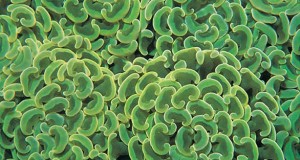Hello, Frank Indiviglio here.
Sea slugs are shell-less, swimming mollusks that are much favored by marine aquarists for their beautiful colors and unusual lifestyles. Studies at Texas A&M University recently (December, 2008) revealed just how unusual their survival strategies can be.
Stealing Plant Cells to Produce Food
It has been known for some time that that the emerald elysia, a sea slug native to North America’s Eastern Seaboard, is dependent, in an odd sort of way, upon one species of marine algae (seaweed). Newly discovered details of its relationship with the algae are startling. It seems that these sea slugs are unique among animals in being born with at least 1 gene that supports photosynthesis.
However, newborn sea slugs cannot actually harness the sun’s energy and utilize it to produce food, as can algae and plants. For this they must consume the cytoplasm (internal material) of marine algae. Within the cytoplasm are organelles known as plastids (chloroplasts), which trap solar energy and convert it into food. Amazingly, the algae’s plastids continue in this role after being consumed by a sea slug.
The Switch – Consuming Energy to Producing Energy
The newly discovered sea slug photosynthetic gene seems to be the key factor in allowing this unique relationship to function – without it, the alga’s plastids would not likely survive in such an alien environment.
In essence, the sea slug converts itself into a solar powered, plant-like animal – the only known example of such a phenomenon! Some marine biologists speculate that, given time, the emerald elysia might evolve into a truly photosynthetic animal.
Something new and unexpected is always popping up in this wonderful field of ours – please pass along your own news tidbits. Thanks, until next time, Frank Indiviglio.
Background information on the emerald elysia’s unique feeding mode is posted at:
http://sbe.umaine.edu/symbio/
 That Fish Blog – Aquarium Advice and Information
That Fish Blog – Aquarium Advice and Information



What water temperature can a tiger barb live in? Does it need to be heated?
Tiger Barbs are tropical freshwater fish, so will need to use a heater to keep these fish happy. An ideal temperature range to keep these fish is 74 – 78 degrees.